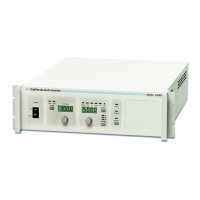6.3.3 Measurement Calibration - Full Scale
Note: Measurement calibration can be done at any output frequency setting as
only one set of calibration coefficients is used for measurement
calibration. However, for best results, calibrate the measurements at the
frequency which is used in most applications, e.g. 50 Hz, 60 Hz (except
model 2003RP-AV) or 400 Hz.
Refer to Table 6-1 for correct load resistors based on model number.
Full Scale Voltage Measurement Calibration
1. Connect the test equipment to the power source as shown in Figure 6-1. Do not connect
any load during this step. Voltage calibration must be done under no load conditions.
2. Select the High Voltage Range and program the output voltage to 230.0 VAC.
3. Put the 2003RP in CAL mode by pressing the recessed CAL button.
4. Use the SELECT key to select the Voltage Measurement calibration mode. This mode is
indicated by the FREQ LED.
5. Use the left control knob to adjust the voltage reading shown on the right hand 7
segment LED until it reads as close as possible to the reference reading as displayed on
the external DMM.
Full Scale Current Measurement Calibration
1. Connect the test equipment to the power source as shown in Figure 6-2.
2. Apply the resistive load (see Table 6-1 for model and load) to the output terminals. Set
the power source to low voltage range.
3. Program the output voltage to a value that produces between 3 and 3.9 amps. Do not
load the output to more than 3.9 amps.
4. Use the SELECT key to select the Current Measurement calibration mode. This mode is
indicated by the I RMS LED.
5. Use the left control knob to adjust the current reading shown on the right hand 7 segment
LED until it reads as close as possible to the reference reading indicated by DMM1
(measuring the current shunt voltage). Note that .39 V reading represents 3.9 Amps if
the recommended 100 m shunt is used.
Full Scale Peak Current Measurement Calibration
1. Connect the test equipment to the power source as shown in Figure 6-2.
2. Apply the resistive load (see Table 6-1 for model and load) to the output terminals. Set
the power source to low voltage range.
3. Program the output voltage to a value that produces between 3 and 3.9 amps. Do not
load the output to more than 3.9 amps.
4. Use the SELECT key to select the Peak Current Measurement calibration mode. This
mode is indicated by the I PK LED.
5. Use the left control knob to adjust the peak current reading shown on the right hand 7
segment LED until it reads as close as possible to the reference reading derived from the
external DMM (DMM 1). Remember the peak current value is equal to 1.414 times the
value shown on the external DMM.

